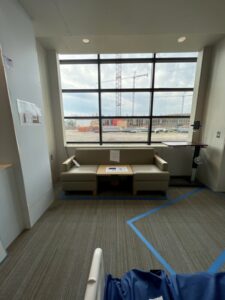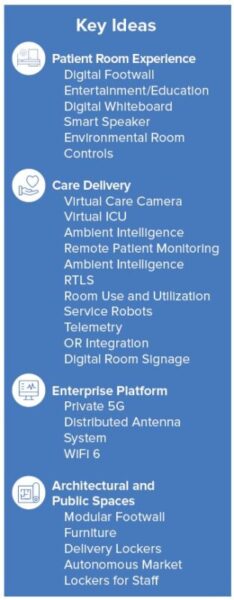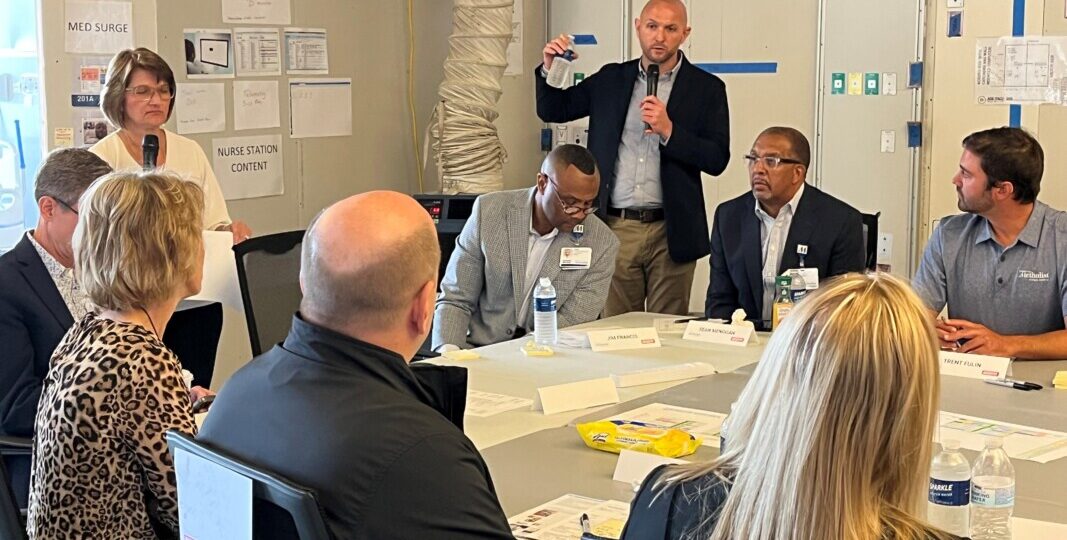Projects • Patient Room Mock-Up
Patient Room Mock-Up
The Hospital of the Future
Houston Methodist Cypress Hospital will be the ninth hospital for the Houston Methodist health system. Scheduled to open in early 2025, the 400-bed “hospital of the future” will incorporate the most advanced technology available, much of it designed to make patient communication with physicians, staff, and families the most effective of any healthcare facility.
Working with the client’s internal innovation department, the project’s architectural team, and key leaders, SSR was tasked with translating the patient care room proofs-of-concept from the innovation team to the design and construction team. Making use of life-sized, fully dimensional replicas of the proposed universal care, ICU, and NICU inpatient room suites, SSR conducted a day-long immersive workshop to engage hospital leaders and rigorously test concepts, infrastructure requirements, and design implications.
Client Need: Translation Between High-Tech Concepts and Design/Construction
 In conventional healthcare facility construction decision making, limited bandwidth of executive leadership and daily distractions of clinicians inevitably results in side-meetings and subsequent cross-checking that cause decisions and enthusiasm to stall. As an industry standout in purposeful design, conventional practices were proving to be barriers to the successful completion of the design and construction of the hospital’s new patient care rooms. The client’s commitment to technology was misaligned with old collaborative practices that were unable to guide the project to the realization of a new high-tech model in healthcare.
In conventional healthcare facility construction decision making, limited bandwidth of executive leadership and daily distractions of clinicians inevitably results in side-meetings and subsequent cross-checking that cause decisions and enthusiasm to stall. As an industry standout in purposeful design, conventional practices were proving to be barriers to the successful completion of the design and construction of the hospital’s new patient care rooms. The client’s commitment to technology was misaligned with old collaborative practices that were unable to guide the project to the realization of a new high-tech model in healthcare.
To mitigate risk and resolve decisions quickly and collaboratively, while reinforcing the project’s unique merger of innovation, design/construction, and budget, SSR proposed an immersive, interactive workshop using the mockup rooms as a base of operations. The workshop was designed to deliver cohesive team building, efficient project education, and effective decision making among all relevant stakeholders including members of the C-suite, clinical team, design and construction team, financial team, and other end users.
SSR Approach: Innovative Design Requires Innovative Planning
 To advance the project through the most challenging phases of decision making, SSR designed an all-hands, in-person workshop to take place in a replica of the patient room concept that was built for this express purpose. Having the right people physically in the room together allowed a collaborative environment for all stakeholders to express opinions and listen to others in real-time, greatly accelerating and streamlining the decision-making process.
To advance the project through the most challenging phases of decision making, SSR designed an all-hands, in-person workshop to take place in a replica of the patient room concept that was built for this express purpose. Having the right people physically in the room together allowed a collaborative environment for all stakeholders to express opinions and listen to others in real-time, greatly accelerating and streamlining the decision-making process.
The project’s architecture and construction team built the mockup rooms on the hospital campus at a location with direct lines of sight to the active construction project – an intentional strategy to underscore the urgency for action to keep up with construction progress. To take optimal advantage of the stakeholder input that would result from the workshop, the event was held just before the final CD (Construction Document) set was to be issued for construction pricing but with enough time to make final tweaks to the CDs.
The schedule of activities strategically covered the four modules of patient room experience, care delivery, enterprise platform and architectural public spaces. Each agenda item included an overview of project areas, a walk-through of the mockup rooms, and opportunities for comments and discussion. The workshop focused on every critical smart room component and its relationships to placement, access, positioning, and aesthetics in and around the room.
Meeting minutes included an actionable PDF linked to the virtual 3D images, giving users the ability to pan, tilt, and zoom into the actual mockup rooms, review the post-it notes placed by attendees of the workshop, and express additional thoughts and opinions. We found this strategy captures those revelations that often occur to stakeholders hours or even days after a creative event, once they have returned to their duties and can compare what they learned to their current workflow, technology, and environmental layout.
Especially unique to this project was including current and future vendors in the conversation. Many of the vendor partners were able to bring newer designs and were actively involved in the specifications of leading-edge technology.
Results and Outcomes
SSR was able to “unlock” progress on the project, moving it from the planning phase to the implementation phase. Specifically:
– All project team members had the chance to give feedback with executive leadership present and engaged. Providing the platform to hear leadership decisions and response in real time was extremely valuable in moving the project forward.
– Validating and documenting decisions with all the stakeholders in the room created a milestone in the project that allowed all to advance to the implementation phase of the project.
– With all stakeholders present together, communication and education on the vision and mission of the hospital was aligned across disciplines.
– Budget alignment among the infrastructure, IT, and the innovation teams was approved with executive leadership and financial team support.
The workshop format and interdisciplinary process brought speed to decisions, budget approval, and design and construction decision making, with much greater confidence that the finished design would include all stakeholder perspectives.


